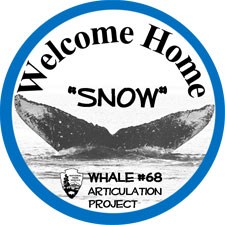
Follow the Journey of Whale 68, aka SnowPhase 2 - Articulation and DisplayThis page contains the many blog posts written by NPS Rangers that followed the effort to permanently display and commemorate this incredible animal at Glacier Bay National Park's headquarters in Bartlett Cove. This page contains blog posts from Phase 2 of the project only. Click here to return to Phase 1.Near the top of this page, you will see the first blog post introducing the Whale 68/Snow articulation project. The blogs will continue chronologically downward on the page, with the final blog post at the very bottom of the page. Use the Table of Contents below to navigate to individual blogs. Whale #68 is on display in Bartlett Cove today, where visitors near and far can visit Snow and see her immense size and beauty. Online, read more about Snow's journey from discovery to display. Return to Phase 1Click below to return to the Phase 1 blog posts in the Whale 68 Blog Archive. 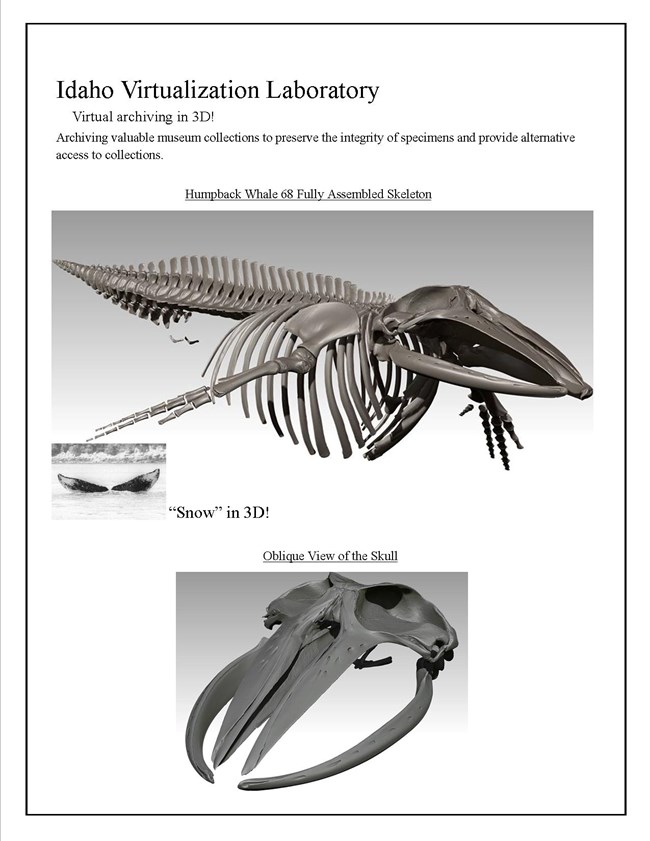
June 3, 2013 Whale 68's Bones in 3D!Blog Authored By: K. VandenBerg With all repairs complete, Whale 68 was ready for her first photo shoot! In April, researchers from the Idaho Virtualization Lab (IVL) traveled to Dan Dendanto's Whales and Nails workshop in Seal Cove, Maine to 3D scan Whale 68's entire skeleon. Due to her large size, she had to be moved to a different facility in order to allow for easier manipulation and rotation of her bones. Every surface of each bone had to be scanned in order to create a 3D image. Dan facilitated the careful packing and transport of the skeleton for the six mile journey from his workshop to the IVL rented workspace. It took the IVL team over two weeks to transport and scan each bone. The final images will be added to The Virtual Zooarchaeology of the Arctic Project (VZAP) library as an osteological reference collection for the study of northern vertebrates. https://vzap.iri.isu.edu/ Whale 68 is the first humpback whale specimen to be added to IVL's "Whales of the World Project." She is only the third fully articulated whale skeleton in digital space! This dynamic natural history archive will be a tremendous tool for students and researchers to study comparative collections which are detailed, up-to-date, and comprehensive. VZAP is funded by grants from the National Science Foundation. One of their goals is, "To democratize science, by providing free access to reference materials for researchers, educators, and students interested in the osteology of northern vertebrates. If a visit to Glacier Bay is not in the near future for you, maybe you will be able to experience Whale 68 digitally! Stay tuned! 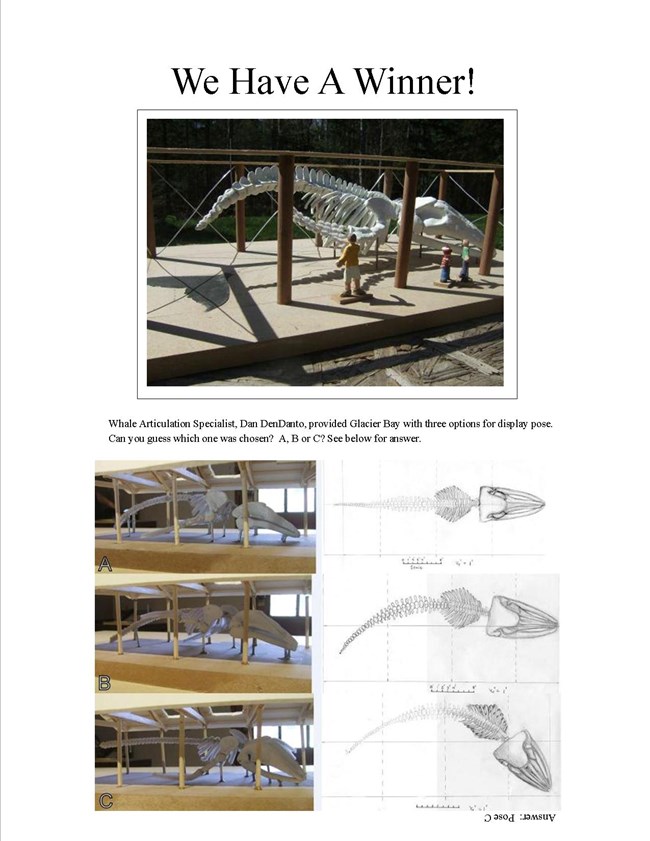
June 3, 2013 We Have A Winner!Blog Authored By: K. VandenBerg After much consideration, the park has chosen a final pose for the Whale 68 Exihibit. At the park's request, Whale Articulation Specialist, Dan DenDanto, provided the Whale Team with three scaled models from which to choose. Using modeling clay, pipe cleaners, and recycled wood, he created very accurate three-dimensional models of the whale and the shelter. The team's desire to showcase a natural pose that would allow maximum viewing opportunities and accurately reflect the anatomy and movement of a humpback whale led them to their choice. Can you guess which pose was selected? The answer is at the bottom of the picture. 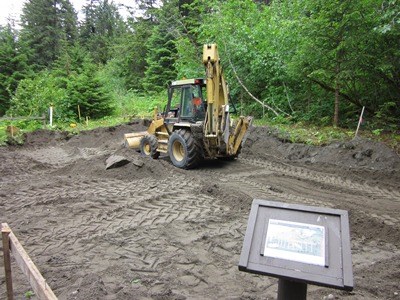
June 24, 2013 Breaking GroundBlog Authored By: K. VandenBerg Summer is in full swing at Glacier Bay! Wildflowers are blooming in rainbows of color, plants are producing prolifically, and animals are gorging on nature's bounty! Park visitors have also arrived! To add to this flurry of activity, park maintenance staff recently broke ground on the Whale 68 Shelter Site! In just a few short months, the shelter that will house Whale 68's enormous 45 ft. skeleton will be complete. Stay tuned for more updates as this phase of the project takes place in Bartlett Cove. 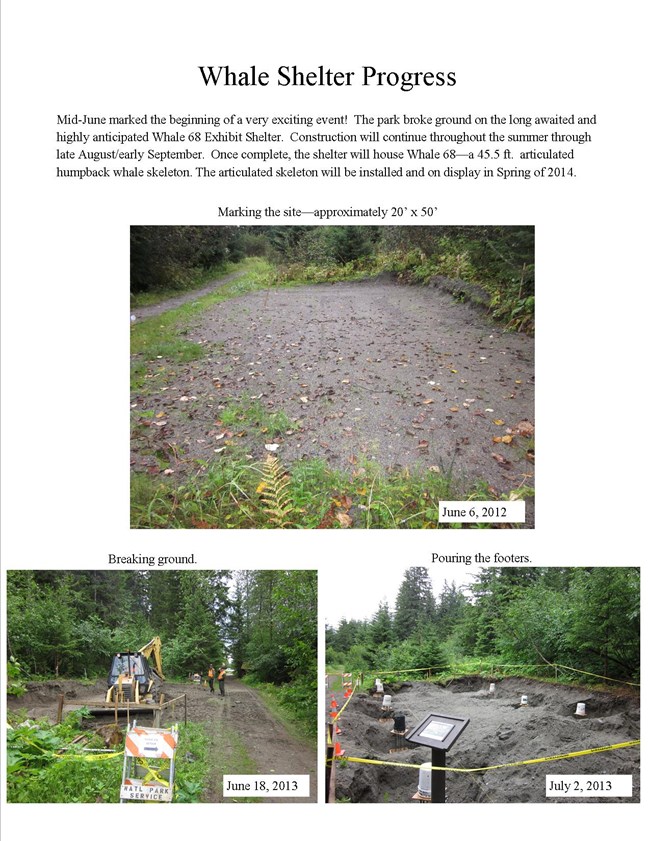
July 15, 2013 Whale Shelter Exhibit Under ConstructionBlog Authored By: K. VandenBerg Whale 68 may physically be 3,000 miles away, but the park is moving forward with plans for her return. In mid-June, the park officially broke ground for the Whale 68 Exhibit Shelter. By early July, strong footers were poured to hold the large, log posts that will support the building. Stay tuned for updates on this exciting building project in Bartlett Cove. 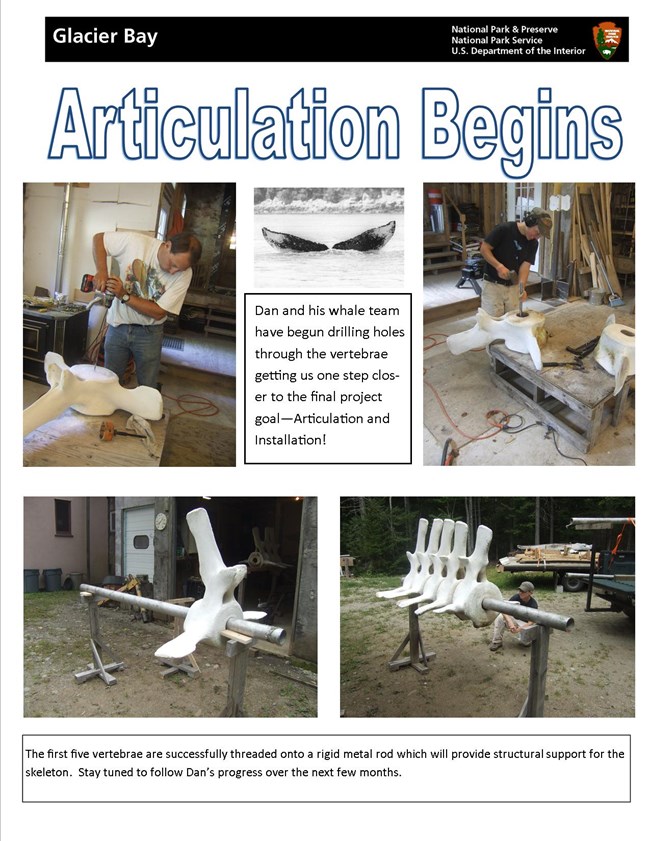
September 16, 2013 Articulation Begins!Blog Authored By: K.VandenBerg For the past several weeks, Dan DenDanto and the Whale & Nails Team have been busy drilling, chiseling, and threading clean bones! They are preparing Whale 68's skeleton for articulation - artistically putting the bones back together for display. Using variety of tools, some of which Dan specially made, the team began the arduous task of cutting through the core of each vertebrae. Some are over 12" deep which required alternating between drilling and chiseling. Dan started the process (see picture) by using a long pilot drill bit to center a drill hole through the centrum of the bone. He says, "This is important to ensure the hole will be along the axis of the spine so that there is good, "square" alignment between the vertebrae when they are threaded on to the pipe." The complete articulation of Whale 68 will take place in sections. This section (see photo) shows five vertebrae threaded on to an 8' metal pipe to "ensure that alignment is true and each vertebrae lines up nicely with the ones before and after." It took Dan and his crew about a week to drill and chisel all the holes though the vertebrae. Stay tuned for more updates as we follow this exciting project. 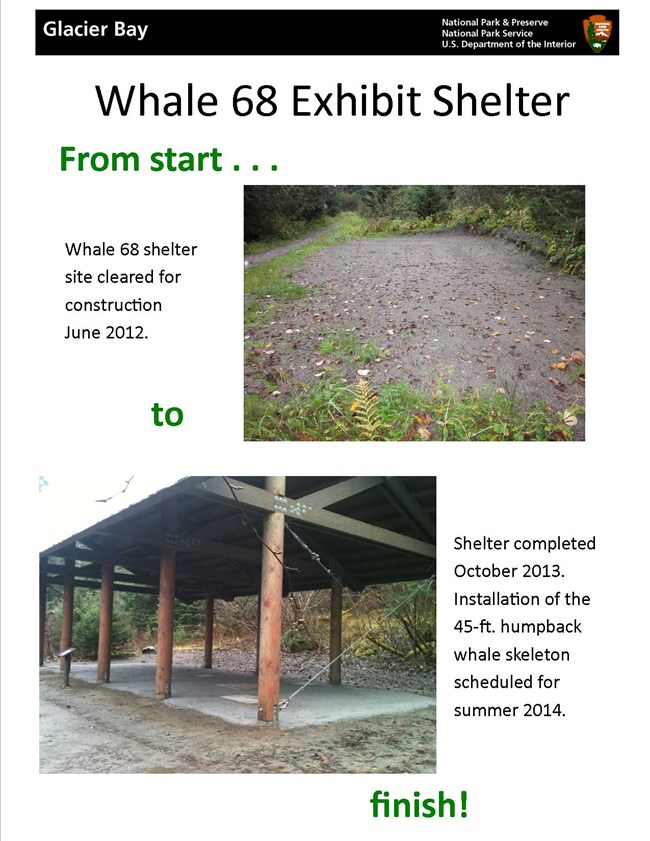
November 28, 2013 A Whale of a House!Blog Authored By: K. VandenBerg The park is one step closer to a world class exhibit! A big "thank you" to Glacier Bay's construction crew who took great pride and care in building the perfect "house" for a whale. The newly completed shelter will house the enormous 45-ft. skeleton of Humpback Whale 68. She will be the second largest specimen on display in North America, and quite possibly the world! The park is celebrating this milestone - one of many along the 12-year journey to give "Snow," a permanent home in Glacier Bay. The project will culminate with the installation of the articulated whale by Dan DenDanto of Whales & Nails (https://whalesandnails.com/baleen-whales) June 2014. Stay tuned for more on this exciting project! 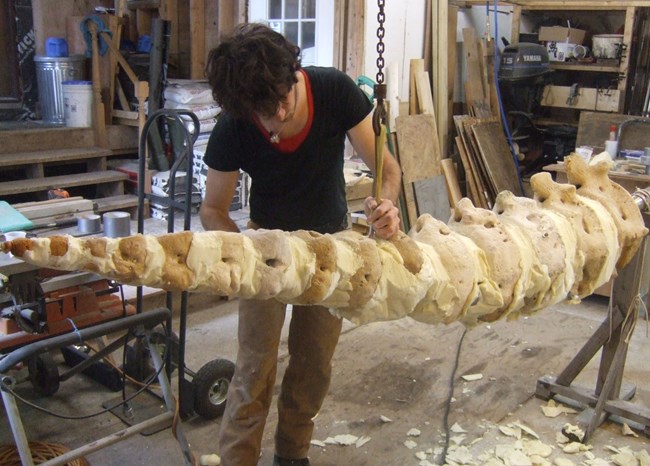
July 7, 2014 Adding the CartilageBlog Authored By: K. VandenBerg Progress on articulation slowed down a bit as winter gripped Maine in her icy clutches. Record snowfall forced the crew inside for most of December, January and February, but the hard work continued. The finish work on the spine sections and the flippers became the focus during this time. The materials that would be used to finish these sections needed to be applied in a dry, warm environment - mainly urethane foam and epoxy. The sixty-four individual vertebrae were combined into three modules for easy transport back to Glacier Bay. To simulate cartilage between each bone urethane foam was used to fill the spaces. The expanding foam acts like glue compressing the vertebrae together to secure them in place. A final coat of epoxy and taxidermy putty will give each section the look of a finished spine. Great strides were made in the spring as temperatures warmed and Dan and his crew were able to get outside.The entire skeleton was mocked up to simulate installation in Glacier Bay. By completing this critical step, the crew would insure an easy transition from the shop to the shelter, anticipating any problems that might arise before arriving in Glacier Bay. 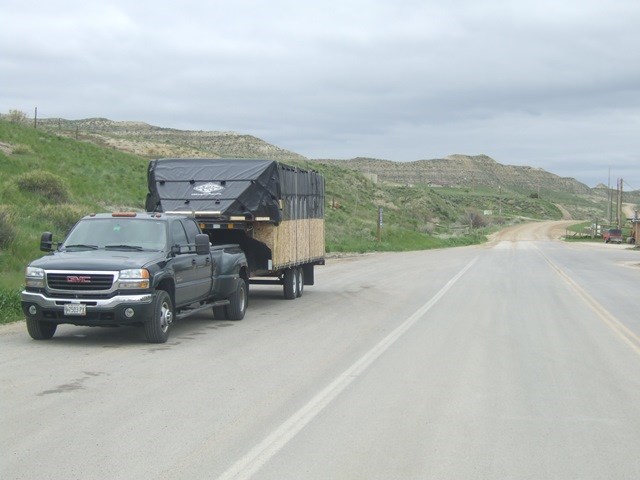
July 7, 2014 The Long Journey HomeBlog Authored By: K. VandenBerg In late May, Dan and the Whales and Nails crew began their long journey back to Glacier Bay.Their 3,000 mile trip took them across the country from Maine to Bellingham and then north to Gustavus, Alaska by Marine Highway. Over the past two years Snow has been in good hands, but we are excited to have her home. Her migration to and from Maine marks the culmination of 13 years of dedication and hard work by many park staff, partners, and volunteers. A beautiful outdoor pavilion awaits her return and will showcase the largest humpback skeleton on display in the United States. Whales and Nails is scheduled to arrive in Glacier Bay on May 28th and complete installation by June 7th. Stay tuned! 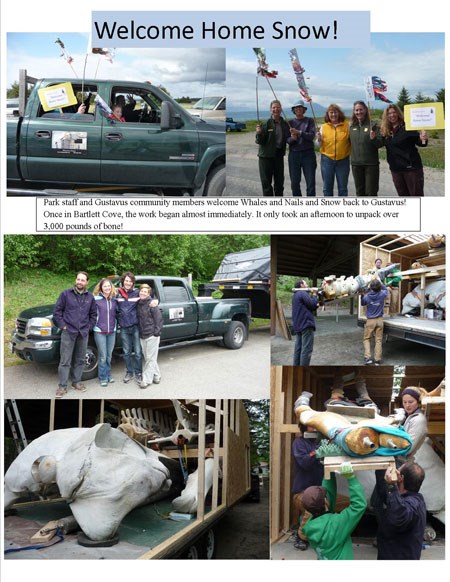
July 8, 2014 Articulation Begins In Bartlett CoveBlog Authored By: K. VandenBerg Shortly after arriving in Gustavus, Whales and Nails transported Snow to Bartlett Cove. For two members of the crew, it was their first time visiting Alaska and they were thrilled to be in Glacier Bay! Once on site, the park maintenance staff helped Dan navigate the rather large truck and trailer combo around some tight corners and down to the whale shelter. It took the whale crew most of an afternoon to unload approximately 3,700 pounds of humpback whale bones and almost 2,000 pounds of steel and hardware. Most of the freight was unloaded by hand, but heavy equipment was needed to lift some of the bones, including the 1300 pound skull and mandibles and two very heavy sections of vertebrae. Over the next two weeks, the crew spent most of their time on site building and adding the finishing touches to the display. Their mock up in Maine proved to be a critical element in the success of the ten day articulation. It was truly a remarkable accomplishment: a 45 1/2 foot, 5,000 pound display, put together by four people in just ten days! Their experience, expert knowledge, and passion made the seemingly impossible, possible. It was obvious that we had world class professionals in our midst. Although the crew made it look easy, Dan stated that there were normal challenges to putting together whales, but the remote location and rainy climate in Glacier Bay presented many unique challenges - epoxy needed more time to dry, a generator secured for electricity, and heated storage for putty and battery recharging. It is noteworthy, that Dan brought all his tools and materials with him and was so well prepared that he only made one trip (an anticipated one) into Gustavus for supplies. Snow will be only one of eighteen fully articulated humpback whale skeletons on public display in the world. Watching the process was fascinating and provided many opportunities for local community members and visitors to enjoy a once-in-a-lifetime experience. 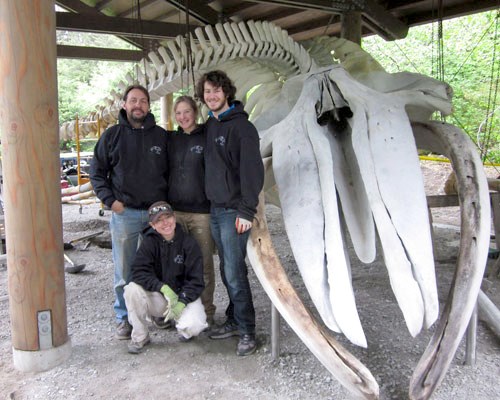
July 8, 2014 Articulation and InstallationBlog Authored By: K. VandenBerg The articulation of Snow (aka Whale 68) is almost complete! The whale team took a few moments to pause and celebrate! 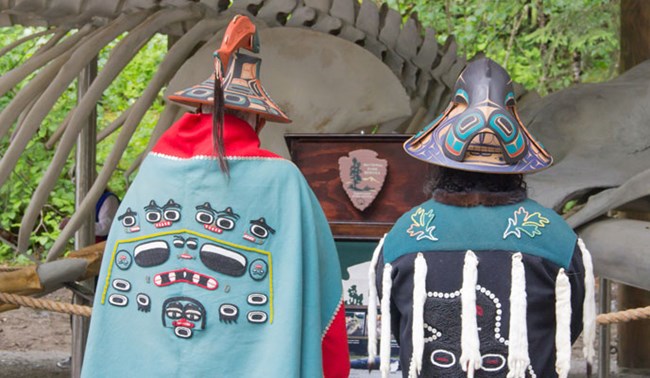
Whale Exhibit Grand Opening - June 25 2014Blog Authored By: K. VandenBerg On June 25th, 2014, Glacier Bay National Park celebrated the Grand Opening of "SNOW," the largest humpback whale skeleton exhibit in the United States. Her massive 3,729 pound skeleton is housed in a beautifully constructed outdoor pavilion just a short walk from the Glacier Bay Lodge. The return of Snow to her permanent home in Bartlett Cove was as much a homecoming as a celebration. The event welcomed many Huna Tlingit families back to their homeland to help dedicate the exhibit and conduct a spirit ceremony that included giving Snow a Tlingit name, "Tsalxaan Tayee Yáay”, which translates as "Whale beneath Mt. Fairweather." The Grand Opening was the culmination of 13 years of hard work by Park staff and volunteers, followed by the expert attention of a professional whale articulation contractor, Dan DenDanto, owner of Whales and Nails LLC. Dan and his crew completed the final cleaning and preparation of bones in Seal Cove, Maine, transporting Snow's skeleton 3,000 miles each way for this work. Displaying this spectacular beautiful skeleton is one way to turn Snow's tragedy into an educational opportunity. We hope that this skeleton will inspire Glacier Bay visitors to learn more about whales and their challenges for decades to come. Learn more about Snow's story here. |
Last updated: May 18, 2021
